Giganten der Lüfte
Author: Andreas Seyfarth
Publisher: Queen Games
Year: 2007
review by

| x |
|
|
|
|
|
|
|
|
|
|
|
|
|
|
|
|
|
|
|
|
|
|
|
|
|
|
|
|
|
|
|
|
|
|
|
|
|
|
|
|
|
|
|
|
|
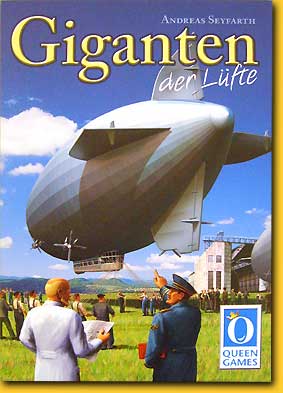 |
Did you ever dream about building airships? Eh, no, neither did we. Anyway, it seems like a nice practice, doesn’t it? Let’s see, what do we need: a hangar, some smart people (engineers), a flight commander, materials, engines, and, last but not least, some money. A lot of resources, also. These resources are used to build airships that will earn the players victory points. Being rather spoilt experienced players, we are used to this kind of resource management. However, in this case the management is done solely by throwing dice, which will raise some eyebrows with the same players. Could this lead to an interesting game?
|
| x |
|
|
|
|
|
|
|
|
|
|
|
|
|
|
|
|
|
|
|
|
|
|
|
|
|
|
|
|
|
|
|
|
|
|
|
|
|
|
|
|
|
|
|
|
|
 |
Each player owns his own company, depicted by an individual player’s board with space for the six resource categories, which are represented by (expansion) cards. Furthermore, each player is given a number of bonus chips in the company colour. .
|
| x |
|
|
|
|
|
|
|
|
|
|
|
|
|
|
|
|
|
|
|
|
|
|
|
|
|
|
|
|
|
|
|
|
|
|
|
|
|
|
|
|
|
|
|
|
|
|
A central game board is placed in the middle of the table. This game board has space for 18 expansion cards: three for each category. At the top of the board the airship cards are placed: four piles with three airship cards each. Each card, being either an expansion or an airship card, has the same format: the top of the card shows the required score to obtain the card and the dice to be used to achieve this score. The bottom of the cards shows the card’s function: victory points for the airship cards. For the expansion cards this differs; mostly additional dice, but also other bonuses
|
| x |
|
|
|
|
|
|
|
|
|
|
|
|
|
|
|
|
|
|
|
|
|
|
|
|
|
|
|
|
|
|
|
|
|
|
|
|
|
|
|
|
|
|
|
|
|
 |
| x |
|
|
|
|
|
|
|
|
|
|
|
|
|
|
|
|
|
|
|
|
|
|
|
|
|
|
|
|
|
|
|
|
|
|
|
|
|
|
|
|
|
|
|
|
|
|
The dice play a central role in this game. They come in three colours: white, red and black, three of each. The white dice have scores from one to three, the red from two to five, and the black from four to eight. Each player starts with a 'capital' of two white dice.
|
| x |
|
|
|
|
|
|
|
|
|
|
|
|
|
|
|
|
|
|
|
|
|
|
|
|
|
|
|
|
|
|
|
|
|
|
|
|
|
|
|
|
|
|
|
|
|
|
A player’s turn starts with the draw of a new expansion card the pile, which is placed in the appropriate category on the central board. Then the player decides which expansion or airship card he wants to acquire. The expansion cards currently on the player’s board show the dice currently at his disposal. When the player has sufficient dice, he tries to throw the required score in a single throw. Let’s assume that a card shows at the top three white dice and a '7', then this means that the player must currently have three white dice at his disposal and that the scores of those dice, after a single throw, added together must be at least '7'. When the total equals '6', then one '+1' bonus chip can be used to acquire the card.
|
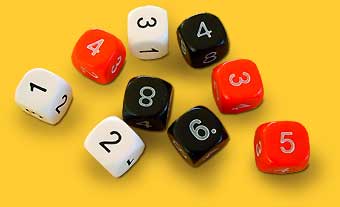 |
| x |
|
|
|
|
|
|
|
|
|
|
|
|
|
|
|
|
|
|
|
|
|
|
|
|
|
|
|
|
|
|
|
|
|
|
|
|
|
|
|
|
|
|
|
|
|
 |
After a successful acquisition, the card is added to the player’s game board, in the appropriate location of course. The card replaces any card lying on this location, replacing it’s function as well. The next turn the function of the new card may be used. When the throw is unsuccessful, the player gets a new bonus chip as compensation. The chips have another function as well. When three of them are paid, the player can have a complete second turn, to give another try at the same card, or acquire a second card.
|
| x |
|
|
|
|
|
|
|
|
|
|
|
|
|
|
|
|
|
|
|
|
|
|
|
|
|
|
|
|
|
|
|
|
|
|
|
|
|
|
|
|
|
|
|
|
|
|
Turn after turn each player builds his own airship company. After a while the red dice become available, and at a later stage the black ones as well. The expansion cards give nice advantages: acquire additional bonus chips, or additional scores for a dice colour. The only thing that counts, however, is the final product: the airships, indicated by the airship cards. These cards give the players their victory points. They are obtained exactly the same way as the expansion cards and are placed on a separate pile on the player’s board. A nice bonus is that after obtaining such an airship card, this player (and this player only) may add one to all his scores. To show this advantage he places a small wooden airship in front of him. With this bonus, and the '+1' bonus chips, this player may now add two to all his scores, which is of course a “boost” for this player’s company, and a sign to his competitors to do something about this bonus.
|
|
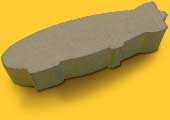 |
| x |
|
|
|
|
|
|
|
|
|
|
|
|
|
|
|
|
|
|
|
|
|
|
|
|
|
|
|
|
|
|
|
|
|
|
|
|
|
|
|
|
|
|
|
|
|
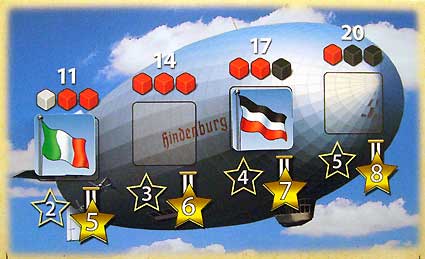 |
x |
After the first pile of airship cards is depleted, work may start on the company’s masterpiece: the 'Hindenburg', depicted at the top of the central game board. While the fate of the real 'Hindenburg' is well-known, in this game a contribution to the building of this airship delivers attractive victory points. |
| x |
|
|
|
|
|
|
|
|
|
|
|
|
|
|
|
|
|
|
|
|
|
|
|
|
|
|
|
|
|
|
|
|
|
|
|
|
|
|
|
|
|
|
|
|
|
| The game ends when the Hindenburg is finished, or, more technically, when each pile of airship cards contains only one card at the most. Now each player counts his victory points on the acquired airship cards, adds his contribution to the Hindenburg, giving that’s the company’s result. The company with the most victory points wins the game. |
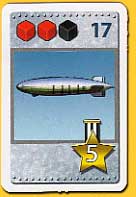 |
| x |
|
|
|
|
|
|
|
|
|
|
|
|
|
|
|
|
|
|
|
|
|
|
|
|
|
|
|
|
|
|
|
|
|
|
|
|
|
|
|
|
|
|
|
|
|
| x |
|
|
|
|
|
|
|
|
|
|
|
|
|
|
|
|
|
|
|
|
|
|
|
|
|
|
|
|
|
|
|
|
|
|
|
|
|
|
|
|
|
|
|
|
|
| x |
|
|
|
|
|
|
|
|
|
|
|
|
|
|
|
|
|
|
|
|
|
|
|
|
|
|
|
|
|
|
|
|
|
|
|
|
|
|
|
|
|
|
|
|
|
 |
|
|
|
|
|
|
|
|
|
|
|
|
|
|
|
|
|
|
|
|
|
|
|
|
|
|
|
|
|
|
|
|
|
|
|
|
|
|
|
|
|
| When seeing the amount of dice in this game, a lot of experienced players will give this game a pass. Not quite fair, since in this game a player’s fate is largely in his own hands. By making bad or good choices the players will see that their companies will prosper or perish. A good, stepwise construction is required, and indeed, the help of Lady Luck is sometimes required. |
| x |
|
|
|
|
|
|
|
|
|
|
|
|
|
|
|
|
|
|
|
|
|
|
|
|
|
|
|
|
|
|
|
|
|
|
|
|
|
|
|
|
|
|
|
|
|
 |
Tactical decisions are there to be made, however, like which function to select from the airship cards available. Since there are excess airship cards (18 in total, while 12 are used in a game), each game starts slightly different, increasing replayability. |
| xx |
|
|
|
|
|
|
|
|
|
|
|
|
|
|
|
|
|
|
|
|
|
|
|
|
|
|
|
|
|
|
|
|
|
|
|
|
|
|
|
|
|
|
|
|
|
|
'Giganten der Lüfte' is advised to be played with either two or three people; with four there can be too much downtime, also caused by a lack of interaction. Of course the inactive players will give “useful” advise to the active player, but this phenomenon depends on the quality of the gaming group, not on the quality of the game itself.
Dice game will always have their advocates and opponents. What cannot be denied is the fact that in this category Andreas Seyfarth has again shown to be among the best board game authors.
On the negative side, it must be said that the game does not give a lot of material for it’s money, and this material is not meant to fit in the box delivered with it… a lot of air that is being shipped!
Giganten der Lüfte, Andreas Seyfarth, Queen Games - 2 to 4 players, 10 years and up, 45 minutes
|
|
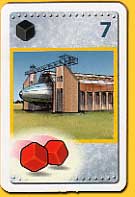 |
  |
|
|
|
|
|
|
|
|
|
|
|
|
|
|
|
|
|
|
|
|
|
|
|
|
|
|
|
|
|
|
|
|
|
|
|
|
|
|
|
|
|
  |
|
|
|
|
|
|
|
|
|
|
|
|
|
|
|
|
|
|
|
|
|
|
|
|
|
|
|
|
|
|
|
|
|
|
|
|
|
|
|
|
|
  |
After initial dislike (dice!), I have begun to really like this game. I especially admire the ability of Andreas Seyfarth to design a different game once again and not get stuck in a game system |
  |
| x |
|
|
|
|
| x |
|
|
|
|
|
|
|
|
|
|
|
|
|
|
|
|
|
|
|
|
|
|
|
|
|
|
|
|
|
|
|
|
|
|
|
|
|
|
|
|
|
|
|
|
|
 |
|
|
|
|
|
|
|
|
|
|
|
|
|
|
|
|
|
|
|
|
|
|
|
|
|
|
|
|
|
|
|
|
|
|
|
|
|
|
|
|
|
 |
|
|
|
|
|
|
|
|
|
|
|
|
|
|
|
|
|
|
|
|
|
|
|
|
|
|
|
|
|
|
|
|
|
|
|
|
|
|
|
|
|
| x |
|
|
|
|
|
|
|
|
|
|
|
|
|
|
|
|
|
|
|
|
|
|
|
|
|
|
|
|
|
|
|
|
|
|
|
|
|
|
|
|
|
|
|
|
|
 |
|
|
|
|
|
|
|
|
|
|
|
|
|
|
|
|
|
|
|
|
|
|
|
|
|
|
|
|
|
|
|
|
|
 |
|
|
|
|
|
|
|
|
|
|
|
|
|
|
|
|
|
|
|
|
|
|
|
|
|
|
|
|
|
|
|
|
|
|
|